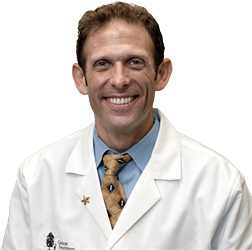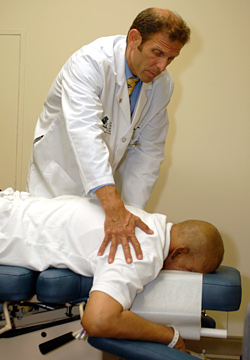Few health challenges frighten patients more than cancer. From warning signs to early testing to confirmation of the diagnosis to the arduous and often-uncertain treatment process, patients must face their potential mortality and be able to say, "I will not let cancer beat me."
Q: Give our readers some background on your chiropractic career, including why you decided to become a chiropractor. After graduating from Palmer College in Davenport in 1997, I returned to the East Coast and have been practicing chiropractic ever since. My passion for chiropractic began in the early '90s as a patient. The success my DC had with my neck pain was unparalleled when compared with numerous other remedies I had tried, including pain medication and massage. I became attracted to the paradigm to which my chiropractor subscribed. I asked him to basically mentor me as I shifted from a reactive style of living to a proactive approach regarding my health and well-being.
 He suggested that I move to Davenport, Iowa and attend Palmer College. Without hesitation, I took his advice. My first year in practice led me to Scranton, Pa., where I worked in an integrated practice with both MDs and DCs. I eventually moved back home to center city Philadelphia, where I opened an integrated wellness center that in addition to chiropractic, offered massage, acupuncture, nutritional counseling, behavioral health services, yoga, Pilates, personal training, etc.
He suggested that I move to Davenport, Iowa and attend Palmer College. Without hesitation, I took his advice. My first year in practice led me to Scranton, Pa., where I worked in an integrated practice with both MDs and DCs. I eventually moved back home to center city Philadelphia, where I opened an integrated wellness center that in addition to chiropractic, offered massage, acupuncture, nutritional counseling, behavioral health services, yoga, Pilates, personal training, etc.
Q: Describe the process that led to your hiring by Cancer Treatment Centers of America. As my practice grew, a couple of practitioners from my office were working part time at Cancer Treatment Centers of America in Philadelphia. One of them mentioned to me that CTCA was looking for a part-time chiropractor. I had strong feelings about treating a patient population fighting cancer, as three immediate members of my family have battled with different forms of cancer.
After receiving a tour of the hospital and meeting with the administration, I was completely blown away by how the facility embraced integrative care in way I had never seen. Medical oncologists, surgeons and radiation oncologists were working alongside naturopaths, acupuncturists and nutritionists. I learned about the "Mother Standard," a model of care practiced at CTCA whereby every patient and care giver is treated like one would treat a member of their own family. To me, CTCA was so in line with my own beliefs in treating patients that it was a perfect fit.
Q: Briefly describe the mission and operations of CTCA. The mission of CTCA is to be the premier center for integrative cancer treatment, demonstrating unparalleled compassion as we provide powerful and innovative therapies to heal the whole person, improve quality of life and restore hope.
We believe in patient empowerment and aim to educate patients with information about all their treatment options so they can make the decision that is best for them. With the focus on the patient's needs and wants regarding their treatment, patients are given many choices regarding their cancer treatment as well as complementary alternative medicine options alongside their [traditional cancer] therapy.
Q: What are your specific responsibilities as a member of the CTCA team? Describe a characteristic patient interaction from a chiropractic perspective, including what you can and cannot do. At CTCA in Philadelphia, I treat cancer patients, their family members and hospital staff. Regarding the cancer patients specifically, chiropractic plays a vital role. Whether a patient has a pre-existing condition that their hometown chiropractor has trepidation about treating or the patient is experiencing side effects from chemotherapy or radiation treatment, I have immediate access to the most recent scans, PET, CT, MRI and bloodwork. This allows me to treat with the utmost safety and precaution, as I am aware of any contraindications for treatment. There are several contraindications to treatment:
- Primary bone cancer: no treatment within five spinal segments or to the affected extremity
- Unstable bone metastases: no treatment available within five spinal segments
- Cord compression from space-occupying lesion
- Any extremity with a thrombosis
- Extreme levels of low platelet count
Patients are allowed to self-refer to me for treatment. However, many of my patients are referred from internists, PAs, physical therapists, oncologists and care managers.
 Dr. Sklar provides chiropractic care as part of the multidisciplinary health care team at Cancer Treatment Centers of America in Philadelphia.
Sometimes new pain arises in a patient. It may be from chemotherapy, from lying on a radiation treatment table in an uncomfortable position or possibly the cancer itself. I have full hospital privileges and can place orders for bloodwork, X-rays and MRIs if necessary.
Dr. Sklar provides chiropractic care as part of the multidisciplinary health care team at Cancer Treatment Centers of America in Philadelphia.
Sometimes new pain arises in a patient. It may be from chemotherapy, from lying on a radiation treatment table in an uncomfortable position or possibly the cancer itself. I have full hospital privileges and can place orders for bloodwork, X-rays and MRIs if necessary.
Techniques that I use vary from patient to patient. I see a lot patients with chemo-induced neuropathy, gait imbalance and muscular weakness. In addition, radiation treatments can create tissue fibrosis, which chiropractic can help alleviate. Finally, the stress and anxiety that goes along with a diagnosis of cancer and its treatment can create severe musculoskeletal tension and pain.
Many patients have a combination of all the above and are very grateful that CTCA makes chiropractic services available. Furthermore, having a team of naturopaths and acupuncturists to consult about different cases enhances the level and quality of care and treatment that patients receive.
Q: With CTCA, what are your interactions with members of other health care professions? How does each team member contribute to patient care? Every morning there are team meetings to discuss the patients being treated on that day. At each meeting that I attend, there is an oncologist, naturopath, dietician and nutritionist, care manager, psychologist/counselor, and physical and occupational therapists. There is a patient empowerment checklist to make sure that all the patients' needs are being met. Cases are discussed and consults and referrals are implemented based on each patient's current status.
If a patient is experiencing headaches from new chemo, the oncologist will hear from team members on how to alleviate the discomfort. At this point, I will suggest a visit with me, as well as seeing someone from the mind-body department. There are often reports of new neuropathy symptoms occurring. The naturopath may recommend glutathione in addition to seeing me. Patients with lymphedema will be referred to OT for lymphatic drainage technique.
There are a number of side effects to treatment. The different departments do the best they can to communicate with each other and to the patient so the patient will receive everything they can to improve their current situation. Whether it be a different supplement, an herb, acupuncture or an adjustment, the patient has an opportunity to receive any and all services that are indicated for their condition.
Q: What are the challenges and rewards of your role on the CTCA team, both personally and as a member of the chiropractic profession? My personal and professional challenges are of course patient centered. Professionally, I am responsible for locating and correcting vertebral subluxations. The challenge is selecting the most appropriate safe and effective technique. Having access to the most recent diagnostic tests (PET scans, MRI, CT, bloodwork, etc.) is an invaluable tool regarding patient safety and treatment success.
Certainly the emotional challenge of dealing with loss can be quite taxing. CTCA has an amazing pastoral care department for patients, caregivers and staff.
Regarding the rewards for working at CTCA with a patient population that gives an undaunted fight for life every day, I have to say that spending time with this awesome group of people is where I find the most satisfaction. The fact that they thank me for spending time with them and providing chiropractic care; well, what can I say? I pinch myself every day when I get to go to work.
Q: Any advice for chiropractors interested in participating in multidisciplinary cancer care, for the CTCA or elsewhere? The place to begin for any chiropractor interested in working at a hospital of any kind is to apply for hospital privileges. There is a Web site called www.hospitaldc.com; it is the site for the American Academy of Hospital Chiropractors. They can guide any DC through the process of receiving privileges.




